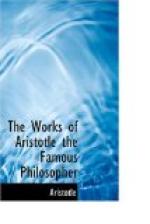Hence it is, they say, that the child more frequently resembles the mother than the father, because the mother contributes more towards it. And they think it may be further instanced, from the endeared affection they bear them; for that, besides their contributing seminal matters, they feed and nourish the child with the purest fountain of blood, until its birth. Which opinion Galen affirms, by allowing children to participate most of the mother; and ascribes the difference of sex to the different operations of the menstrual blood; but this reason of the likeness he refers to the power of the seed; for, as the plants receive more nourishment from fruitful ground, than from the industry of the husbandman, so the infant receives more abundance from the mother than the father. For the seed of both is cherished in the womb, and then grows to perfection, being nourished with blood. And for this reason it is, they say, that children, for the most part, love their mothers best, because they receive the most of their substance from their mother; for about nine months she nourishes her child in the womb with the purest blood; then her love towards it newly born, and its likeness, do clearly show that the woman affords seed, and contributes more towards making the child than the man.
But in this all the ancients were very erroneous; for the testicles, so called in women, afford not only seed, but are two eggs, like those of fowls and other creatures; neither have they any office like those of men, but are indeed the ovaria, wherein the eggs are nourished by the sanguinary vessels disposed throughout them; and from thence one or more as they are fecundated by the man’s seed is separated and conveyed into the womb by the ovaducts. The truth of this is plain, for if you boil them the liquor will be of the same colour, taste and consistency, with the taste of birds’ eggs. If any object that they have no shells, that signifies nothing: for the eggs of fowls while they are on the ovary, nay, after they are fastened into the uterus, have no shell. And though when they are laid, they have one, yet that is no more than a defence with which nature has provided them against any outward injury, while they are hatched without the body; whereas those of women being hatched within the body, need no other fence than the womb, by which they are sufficiently secured. And this is enough, I hope, for the clearing of this point.




